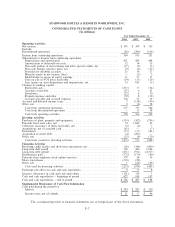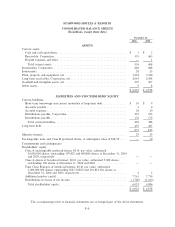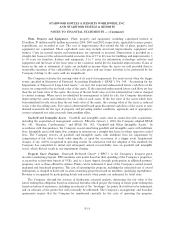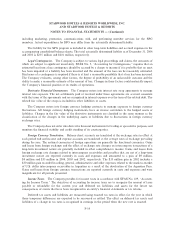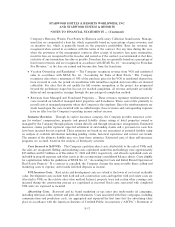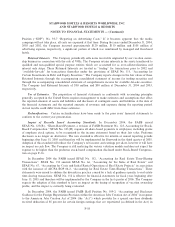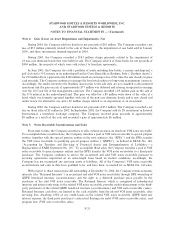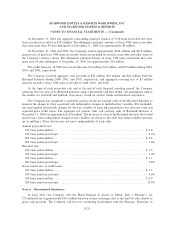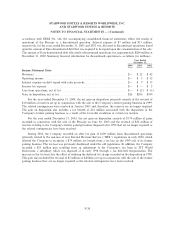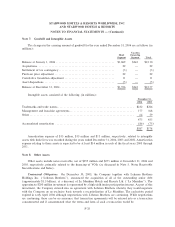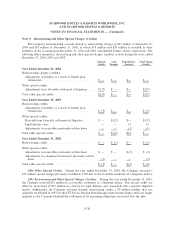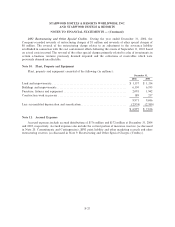Starwood 2004 Annual Report Download - page 83
Download and view the complete annual report
Please find page 83 of the 2004 Starwood annual report below. You can navigate through the pages in the report by either clicking on the pages listed below, or by using the keyword search tool below to find specific information within the annual report.STARWOOD HOTELS & RESORTS WORLDWIDE, INC.
AND STARWOOD HOTELS & RESORTS
NOTES TO FINANCIAL STATEMENTS Ì (Continued)
Company's Sheraton, Westin, Four Points by Sheraton and Luxury Collection brand names. Manage-
ment fees are comprised of a base fee, which is generally based on a percentage of gross revenues, and
an incentive fee, which is generally based on the property's proÑtability. Base fee revenues are
recognized when earned in accordance with the terms of the contract. For any time during the year,
when the provisions of the management contracts allow receipt of incentive fees upon termination,
incentive fees are recognized for the fees due and earned as if the contract was terminated at that date,
exclusive of any termination fees due or payable. Franchise fees are generally based on a percentage of
hotel room revenues and are recognized in accordance with SFAS No. 45, ""Accounting for Franchise
Fee Revenue,'' as the fees are earned and become due from the franchisee.
¬Vacation Ownership and Residential Ì The Company recognizes revenue from VOI and residential
sales in accordance with SFAS No. 66, ""Accounting for Sales of Real Estate.'' The Company
recognizes sales when a minimum of 10% of the purchase price for the VOI or residential deposit has
been received in cash, the period of cancellation with refund has expired and receivables are deemed
collectible. For sales that do not qualify for full revenue recognition as the project has progressed
beyond the preliminary stages but has not yet reached completion, all revenue and proÑt are initially
deferred and recognized in earnings through the percentage-of-completion method.
¬Revenues from Managed and Franchised Properties Ì These revenues represent reimbursements of
costs incurred on behalf of managed hotel properties and franchisees. These costs relate primarily to
payroll costs at managed properties where the Company is the employer. Since the reimbursements are
made based upon the costs incurred with no added margin, these revenues and corresponding expenses
have no eÅect on the Company's operating income and net income.
Insurance Retention. Through its captive insurance company, the Company provides insurance cover-
age for workers' compensation, property and general liability claims arising at hotel properties owned or
managed by the Company through policies written directly and through reinsurance arrangements. Estimated
insurance claims payable represent expected settlement of outstanding claims and a provision for costs that
have been incurred but not reported. These estimates are based on our assessment of potential liability using
an analysis of available information including pending claims, historical experience and current cost trends.
The amount of the ultimate liability may vary from these estimates. Estimated costs of these self-insurance
programs are accrued, based on the analysis of third-party actuaries.
Costs Incurred to Sell VOIs. The Company capitalizes direct costs attributable to the sale of VOIs until
the sales are recognized. Selling and marketing costs capitalized under this methodology were approximately
$23 million and $17 million as of December 31, 2004 and 2003, respectively, and all such capitalized costs are
included in prepaid expenses and other assets in the accompanying consolidated balance sheets. Costs eligible
for capitalization follow the guidelines of SFAS No. 67, ""Accounting for Costs and Initial Rental Operation of
Real Estate Projects.'' If a contract is cancelled, the Company charges the unrecoverable direct selling and
marketing costs to expense, and records forfeited deposits as income.
VOI Inventory Costs. Real estate and development costs are valued at the lower of cost or net realizable
value. Development costs include both hard and soft construction costs and together with real estate costs are
allocated to VOIs on the relative sales value method. Interest, property taxes and certain other carrying costs
incurred during the construction process are capitalized as incurred. Such costs associated with completed
VOI units are expensed as incurred.
Advertising Costs. Starwood and its brand marketing co-ops enter into multi-media ad campaigns,
including television, radio, internet and print advertisements. Costs associated with these campaigns, including
communication and production costs, are aggregated and expensed the Ñrst time that the advertising takes
place in accordance with the American Institute of CertiÑed Public Accountants (""AICPA'') Statement of
F-17


